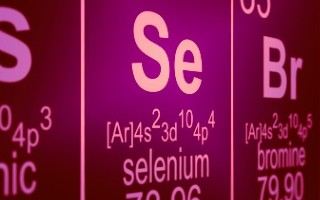 06 Sep 2022
06 Sep 2022
Selenium (Se) is an essential trace element. It is present in inorganic form as selenites and selenates and in organic form as selenoamino acids, seleno peptides and selenoproteins, which are involved in a number of physiologically important processes (see below).

Selenium plays an important biochemical role as a functional component of glutathione peroxidase (GPx) a mammalian antioxidant enzyme. Which is a key component of the body’s antioxidant system.
Some of its other beneficial effects are:
![]()
Selenium is also important for the synthesis, metabolism and function of thyroid hormones, which are crucial regulators of development, growth and differentiation.
Moreover, this mineral plays an essential role in the non-specific immune response and its low levels have been associated with a weakened immune system.
Selenium deficiency leads to reduced activity of GPx and a drop neutrophil activity. While making cells increasingly susceptible to oxidative damage. As it will be described below, Selenium is involved in growth and development, as well as participating in reproduction related processes. These and other functions are described in Figure 1.
Figure 1. Physiological functions of Selenium in the animal organism
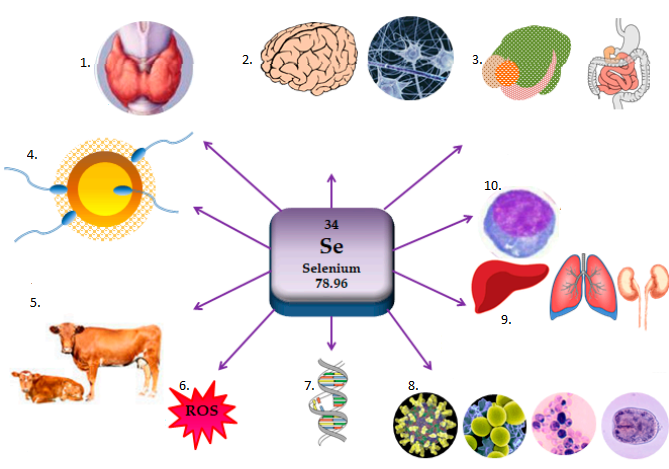
- Thyroid gland: Synthesis and functions of thyroid hormones
- Central nervous system: protective effect against lipid oxidation and modulation of neurotoxicity
- Gastrointestinal tract: positive influence on digestive enzymes and rumen microorganisms
- Reproductive tract: improvement in conception; integrity of sperm membranes
- Growth and development: regulation of growth, differentiation and body development.
- Antioxidant properties: reduction of oxidative stress
- Antimutagenic and anticancer effect: prevention against DNA damage and anticancer
- Antimicrobial and antiparasitic effect
- Liver, kidneys and lungs: protection against liver damage, against pulmonary oxidative damage and against damage caused by heavy metals in the kidney.
- Immune system: immunity regulation and anti-inflammatory properties
Role of selenium in oxidative stress

Redox reactions in respiratory and enzymatic cellular processes can create particularly reactive by-products, oxygen or nitrogen species called reactive oxygen species (ROS) and reactive nitrogen species (RNS), respectively.
The most common sources for exogenous intake of ROS are xenobiotics (drugs, contaminants, toxins, etc.) These may be involved in redox processes within the body, UV radiation, etc.
Diseases associated with selenium deficiency

The varied composition of the body’s antioxidant defense system allows it to benefit from different types of antioxidants. This is well known for selenium and vitamin E deficiencies, in which a nutritional deprivation of one or the other may progress as asymptomatic, while a deficiency of both will result in clinical disease.
In addition to their joint participation within the antioxidant system, their presence is very important for the immune system and to confer resistance towards infections.A well known manifestation of selenium deficiency in calves, lambs, goats, foals and piglets is white muscle disease or nutritional muscular dystrophy (NMD).
Effect of selenium on reproduction
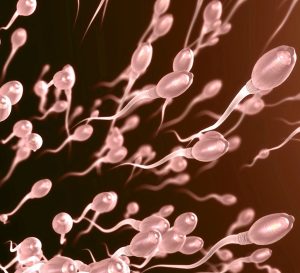
Administration of Se in deficient cows can reduce the number of services per conception. Selenium deficiency has been shown to cause abortions (Kamada et al., 2014) and stillbirths (Uetmaso et al., 2016).
Spears et al. (2008) demonstrated that the administration of Se and vitamin E reduced the incidence of placental retention.
Oxidative stress (OS) is an important factor that negatively affects the potential fertility of sperm by lipid peroxidation. The plasma membrane of sperm is extremely susceptible to lipid peroxidation due to the presence of high concentration of polyunsaturated fatty acids (PUFAs).
Effects of selenium on reducing intramammary infection and milk quality
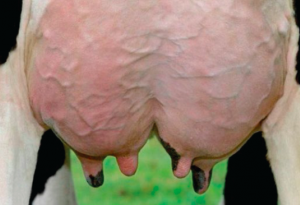
Selenium deficiency is also associated with an increased incidence of mastitis (Surai et al. , 2014), the main defense mechanism against mastitis is the phagocytic activity of neutrophils.
Dietary Se intake at the dose of ≥4 mg/day before delivery was negatively associated with the likelihood of intramammary bovine infections due to coagulase-negative staphylococcus (Passchyn et al., 2014).
Selenium supplementation
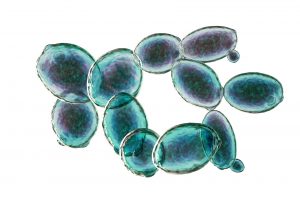
Organic Se may show promise for preventing selenium deficiency, as well as conferring protection against aflatoxins (see Protective effect of curcumin and selenium against AFB1 toxicity)
All mammals and bird species are adapted to metabolize organic selenium with active intestinal absorption. The chemical similarity between methionine and SeMet allows their interchangeable role in the cellular process, resulting in the construction of Se reserves in muscles, playing an important role in oxidative stress conditions.
It is worth evaluating cattle’s Se status, to develop an appropriate supplementation regime. In order to regulate its inclusion in feed, as it has been shown that depending on its source, excess Se can be toxic.
Se supplementation in organic form has been shown to be more efficient when it comes to improving growth parameters and antioxidant status of cattle, poultry and pigs.
Another source that is becoming increasingly important is the inclusion of Se enriched yeast. Rajashree and Muthukumar (2013) reviewed the bioavailability of selenium. The review has pointed to numerous foods as significant sources of bioavailable organic Se predominantly involving Se yeast, Brazil nuts, lentils, and enriched wheat.
Conclusions
Selenium is an important essential element that interferes through selenoproteins in many physiological processes of the organism and affects the production and reproductive properties of livestock. By adequately supplying Se in the diet, health problems associated with its deficiency can be effectively mitigated.
Source: This article was originally published in spanish in NutriNews Latam on July 18, 2022. Titled “Importancia del Selenio para la Salud animal.”
Subscribe now to the technical magazine of animal nutrition
AUTHORS

Nutritional Interventions to Improve Fertility in Male Broiler Breeders
Edgar Oviedo
The Use of Organic Acids in Poultry: A Natural Path to Health and Productivity
M. Naeem
Synergistic Benefits of Prebiotics and Probiotics in Poultry, Swine, and Cattle
Gustavo Adolfo Quintana-Ospina
Hybrid Rye Potential in Laying Hen Feed Rations
Gwendolyn Jones
A day in the life of phosphorus in pigs: Part I
Rafael Duran Giménez-Rico
Use of enzymes in diets for ruminants
Braulio de la Calle Campos
Minerals and Hoof Health in the Pregnant Sow
Juan Gabriel Espino
Impact of Oxidized Fats on Swine Reproduction and Offspring
Maria Alejandra Perez Alvarado